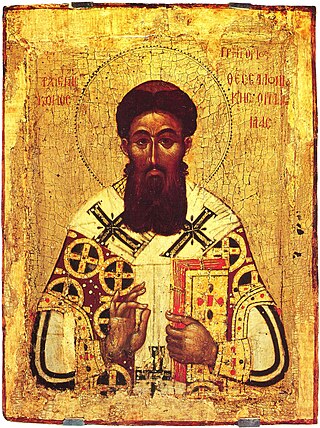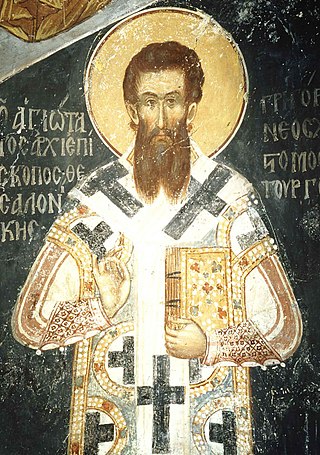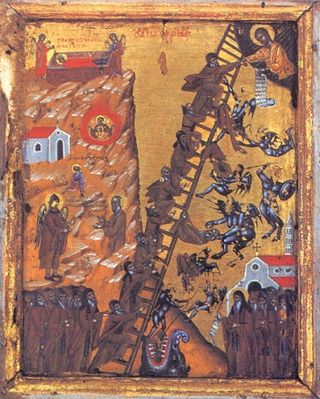
Hesychasm is a contemplative monastic tradition in the Eastern Christian traditions of the Eastern Catholic Church and Eastern Orthodox Church in which stillness (hēsychia) is sought through uninterrupted Jesus prayer. While rooted in early Christian monasticism, it took its definitive form in the 14th century at Mount Athos.

The Jesus Prayer, also known as The Prayer, is a short formulaic prayer, esteemed and advocated especially in Eastern Christianity and Roman Catholicism:
Lord Jesus Christ, Son of God, have mercy on me, a sinner.

Gregory Palamas was a Byzantine Greek theologian and Eastern Orthodox cleric of the late Byzantine period. A monk of Mount Athos and later archbishop of Thessaloniki, he is famous for his defense of hesychast spirituality, the uncreated character of the light of the Transfiguration, and the distinction between God's essence and energies. His teaching unfolded over the course of three major controversies, (1) with the Italo-Greek Barlaam between 1336 and 1341, (2) with the monk Gregory Akindynos between 1341 and 1347, and (3) with the philosopher Gregoras, from 1348 to 1355. His theological contributions are sometimes referred to as Palamism, and his followers as Palamites.
The Philokalia is "a collection of texts written between the 4th and 15th centuries by spiritual masters" of the mystical hesychast tradition of the Eastern Orthodox Church. They were originally written for the guidance and instruction of monks in "the practice of the contemplative life". The collection was compiled in the 18th century by Nicodemus the Hagiorite and Macarius of Corinth based on the codices 472, 605, 476, 628 and 629 from the library of the monastery of Vatopedi, Mount Athos.

Christian mysticism is the tradition of mystical practices and mystical theology within Christianity which "concerns the preparation [of the person] for, the consciousness of, and the effect of [...] a direct and transformative presence of God" or Divine love. Until the sixth century the practice of what is now called mysticism was referred to by the term contemplatio, c.q. theoria, from contemplatio, "looking at", "gazing at", "being aware of" God or the Divine. Christianity took up the use of both the Greek (theoria) and Latin terminology to describe various forms of prayer and the process of coming to know God.

In Palamite theology, there is a distinction between the essence (ousia) and the energies (energeia) of God. It was formulated by Gregory Palamas (1296–1359) as part of his defense of the Athonite monastic practice of hesychasmos against the charge of heresy brought by the humanist scholar and theologian Barlaam of Calabria.

Vladimir Nikolaievich Lossky was a Russian Eastern Orthodox theologian exiled in Paris. He emphasized theosis as the main principle of Eastern Orthodox Christianity.
Eastern Orthodox theology is the theology particular to the Eastern Orthodox Church. It is characterized by monotheistic Trinitarianism, belief in the Incarnation of the essentially divine Logos or only-begotten Son of God, cataphatic theology with apophatic theology, a hermeneutic defined by a Sacred Tradition, a catholic ecclesiology, a theology of the person, and a principally recapitulative and therapeutic soteriology.

Kallistos Ware was an English bishop and theologian of the Eastern Orthodox Church. From 1982, he held the titular bishopric of Diokleia in Phrygia, later made a titular metropolitan bishopric in 2007, under the Ecumenical Patriarchate of Constantinople. He was one of the best-known modern Eastern Orthodox hierarchs and theologians. From 1966 to 2001, he was Spalding Lecturer of Eastern Orthodox Studies at the University of Oxford.
Mystical theology is the branch of theology in the Christian tradition that explains mystical practices and states, as induced by contemplative practices such as contemplative prayer, called theoria from the Greek for contemplation.

Palamism or the Palamite theology comprises the teachings of Gregory Palamas, whose writings defended the Eastern Orthodox practice of Hesychasm against the attack of Barlaam. Followers of Palamas are sometimes referred to as Palamites.

De Coelesti Hierarchia is a Pseudo-Dionysian work on angelology, written in Greek and dated to ca. AD the 5th century; it exerted great influence on scholasticism and treats at great length the hierarchies of angels.
Neoplatonism was a major influence on Christian theology throughout Late Antiquity and the Middle Ages in the West. This was due to St. Augustine of Hippo, who was influenced by the early Neoplatonists Plotinus and Porphyry, as well as the works of the Christian writer Pseudo-Dionysius the Areopagite, who was influenced by later Neoplatonists, such as Proclus and Damascius.

Niketas Stethatos was a Byzantine mystic and theologian who is considered a saint by the Eastern Orthodox Church. He was a follower of Symeon the New Theologian and wrote the most complete biography of Symeon, Life of Symeon.

The Catholic Church and the Eastern Orthodox Church have been in a state of official schism from one another since the East–West Schism of 1054. This schism was caused by historical and language differences, and the ensuing theological differences between the Western and Eastern churches.
Nepsis is a concept in Orthodox Christian theology. It means wakefulness or watchfulness and constitutes a condition of sobriety acquired following a period of catharsis. St. Hesychios the Priest defines nepsis as "a continual fixing and halting of thought at the entrance to the heart."

Theosis, or deification, is a transformative process whose aim is likeness to or union with God, as taught by the Eastern Catholic Churches and the Eastern Orthodox Church; the same concept is also found in the Latin rite of the Catholic Church, where it is termed "divinization". As a process of transformation, theosis is brought about by the effects of catharsis and theoria. According to Eastern Christian teachings, theosis is very much the purpose of human life. It is considered achievable only through synergy of human activity and God's uncreated energies.

The Hesychast controversy was a theological dispute in the Byzantine Empire during the 14th century between supporters and opponents of Gregory Palamas. While not a primary driver of the Byzantine Civil War, it influenced and was influenced by the political forces in play during that war. The dispute concluded with the victory of the Palamists and the inclusion of Palamite doctrine as part of the dogma of the Eastern Orthodox Church as well as the canonization of Palamas.

20th century Eastern Orthodox theology has been dominated by neo-Palamism, the revival of St. Palamas and hesychasm. John Behr characterizes Eastern Orthodox theology as having been "reborn in the twentieth century." Norman Russell describes Eastern Orthodox theology as having been dominated by an "arid scholasticism" for several centuries after the fall of Constantinople. Russell describes the postwar re-engagement of modern Greek theologians with the Greek Fathers, which occurred with the help of diaspora theologians and Western patristic scholars. A significant component of this re-engagement with the Greek Fathers has been a rediscovery of Palamas by Greek theologians; Palamas had previously been given less attention than the other Fathers.
Theoleptos of Philadelphia was a Byzantine monk, Metropolitan of Philadelphia (1283/4–1322) and Eastern Orthodox theologian.










